Hamilton Beach HomeBaker Breadmaker 29881 User Manual | Parts & Features

Content
Introduction
The Hamilton Beach HomeBaker Breadmaker 29881 is a versatile and easy-to-use kitchen appliance that allows you to make fresh, homemade bread in the comfort of your own home. With a sleek design and a variety of features, this breadmaker is perfect for both beginners and experienced bakers. The estimated price of the Hamilton Beach HomeBaker Breadmaker 29881 is around $70-$80 and it was launched in 2019.
Parts and Features

Quick-Start Guide
See “Detailed Instructions” section for additional information.
BEFORE FIRST USE: Wash and dry bread pan and kneading paddle.
NOTE: Do not use metal utensils in bread pan since they may damage the nonstick surface.
CAUTION! Falling Object Hazard. Breadmaker can wobble and walk during kneading cycle. Always position it in the center of the counter away from the edge.
Add Ingredients
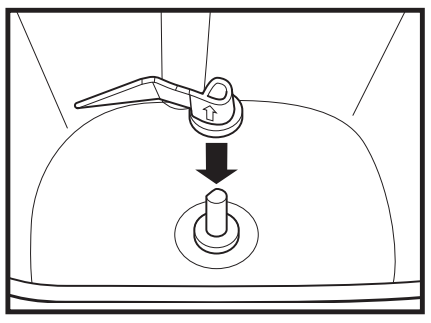
- Place kneading paddle on shaft, with arrow pointing up, pushing down as far as it will go, making sure flat surfaces are lined up.
LAST: Yeast. MUST be separate from wet ingredients
SECOND: Dry ingredients (sugar, salt, shortening, flour)
FIRST: Liquid ingredients – room

- Carefully measure and add ingredients to the bread pan in the EXACT order given in the recipe.
TIP: Premeasure all ingredients, including add-ins (nuts, raisins), prior to beginning. - Place bread pan in the breadmaker, turning clockwise until it locks into place. Close cover.
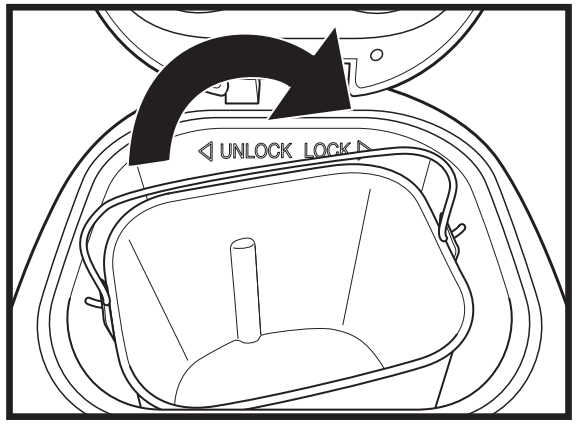
NOTE: Bread pan must lock into place for proper mixing and kneading.
- Place bread pan in the breadmaker, turning clockwise until it locks into place. Close cover.
NOTE: Bread pan must lock into place for proper mixing and kneading.
- Place kneading paddle on shaft, with arrow pointing up, pushing down as far as it will go, making sure flat surfaces are lined up.
- Select Cycle
- Press CYCLE button until desired program number appears on the digital display.
- Press CRUST and LOAF SIZE buttons to ADJUST to desired setting (not adjustable in some cycles).
- To program a Delayed Start, use the DELAY TIMER + or – buttons to add up to 12 hours before Cycle will start. Refer to page 10 for additional information.
- Start Making Bread
- Press START/STOP. The digital display will show the time remaining in the cycle.
- Add-ins: After the second kneading cycle, 10 beeps will signal you to add fruit, nuts, etc.
- Once complete, breadmaker will beep and begin Keep Warm cycle for up to 1 hour. Press START/STOP button for 2 seconds to cancel the Keep Warm cycle and turn off breadmaker.
- Press START/STOP button for 2 seconds to cancel the Keep Warm cycle and turn off breadmaker.
- Using oven mitts, turn counterclockwise to unlock the bread pan, and pull bread pan straight up. Still using oven mitts, shake loaf from pan and let cool for 10 minutes.
Setup Guide
Setting up the Hamilton Beach HomeBaker Breadmaker 29881 is a breeze. First, make sure to wash and dry the bread pan and paddle before use. Then, plug in the breadmaker and select the desired cycle using the LCD display. Add the ingredients in the order listed in the recipe, making sure to add liquids first and dry ingredients last. Place the bread pan in the breadmaker, making sure the paddle is securely in place. Close the lid and press the start button. The breadmaker will do the rest!
Control Panel Hamilton Beach HomeBaker Breadmaker 29881
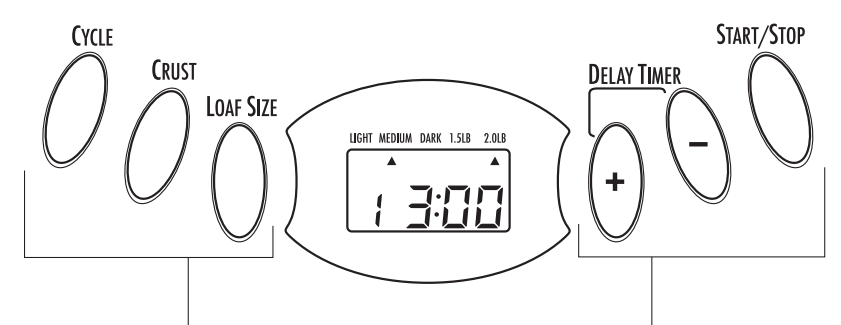
Preprogrammed Cycles
- Basic
- French
- Gluten-Free
- Quick
- Sweet
- 1.5lb. Express
- 2.01b. Express
- Dough
- Jam
- Cake
- Whole Grain
- Bake
CYCLE
- Press CYCLE button to select your desired cycle. The corresponding cycle number is shown on the display. CRUST COLOR
- Press CRUST button to move the arrow to desired setting: Light, Medium, or Dark crust. (Crust is not adjustable in Cycles ®, 9, 10, 0, and 1.) LOAF SIZE
- Press the LOAF SIZE button to move the arrow to 1.5- or 2-lb. loaf size. (Loaf size is not an option in Cycles 0, 0,0.8, 9,00, and (.)
DELAY TIMER
Use the Delay Timer feature to start the breadmaker at a later time. Press the + and - buttons to increase the cycle time shown on the display. Add up to 13 hours including the delay time and breadmaking cycle.
NOTES:
- Set the Delay Time after selecting Cycle, Loaf Size, and Crust Color.
- The 1.5 lb. Express, 2 lb. Express, and JAM cycles do not have a delay function.
- Do not use the timer function with recipes that include dairy or other ingredients, such as eggs, milk, cream, or cheese.
START/STOP BUTTON
- Press the START/STOP button once to start a cycle. A short beep will be heard, the colon in the time display will begin to flash, and the cycle will start.
- To remove bread, press the START/STOP button to end the baking cycle.
- To cancel a cycle, press the START/STOP button for at least 2 seconds.
POWER INTERRUPTION
In the event of a power outage, the process of making bread will continue automatically within 5 minutes. If the interruption time is longer than 5 minutes, the unit will not continue running and the display will revert back to the default setting (Cycle , Medium Color, and 2-lb. loaf). If the dough has started rising, discard the ingredients in the bread pan and start over. If the dough has not entered the rising phase, you can press the START/STOP button to continue the cycle from the beginning.
WARNING DISPLAY
“HHH” – This warning means that the temperature inside of the bread pan is too high. Stop the program, unplug the power cord, open the cover, and let the machine cool down completely before restarting. “LLL” – This warning means that the temperature inside of the bread pan is too low. The room temperature is too low for the breadmaker to function.
KEEP WARM
After baking cycle is complete, the bread machine will shift to the Keep Warm setting for 1 hour. To cancel the Keep Warm process, press the START/STOP button for 2 seconds.
TIP: Removing bread immediately after baking cycle is complete will prevent crust from becoming darker.
- Basic
For white and mixed breads consisting mainly of basic bread flour. - French
For light breads made from fine flour. Normally, the bread is fluffy and has a crispy crust. This is not a suitable setting for recipes requiring butter, margarine, or milk. - Gluten-Free
For gluten-free breads and mixes. - Quick
For quick-bread recipes that do not use yeast for rising and instead may use baking powder or soda. Kneading, rising, and baking loaf within a time less than for basic bread. - Sweet
For breads with additives such as fruit juices, grated coconut, raisins, dry fruits, chocolate, or added sugar. Due to a longer phase of rising, the bread will be light and airy. - 1.5 lb. Express
Kneading, rising, and baking a 1.5-lb. (680-g) loaf occurs in 58 minutes using a quick-rising yeast. Loaf will be smaller and rougher than that made with the Basic cycle. - 2.0 lb. Express
Same as 1.5 lb. Express, but yields a 2-lb. (907-g) loaf. - Dough
This cycle prepares the yeast dough for buns, pizza crust, etc., to be baked in a conventional oven. There is no baking in this cycle. - Jam
For making jams with fresh fruit. - Cake
Kneading, rising, and baking occurs, but with the aid of soda or baking powder. - Whole Grain
For breads with heavy varieties of flour that require a longer phase of kneading and rising (whole wheat flour, rye flour). Bread will be more compact and heavy. - Bake
When additional baking of breads is needed because a loaf is too light or not baked through. There is no kneading or resting.
Detailed Instructions
BEFORE FIRST USE Hamilton Beach HomeBaker Breadmaker 29881
- Check for any missing or damaged parts.
- Clean all the parts according to the Cleaning section.
- Set the breadmaker on Bake mode and bake empty for about 10 minutes. Let unit cool down and clean all the detached parts again.
- The appliance may emit a little smoke and/or odor when you turn it on for the first time.
- This is normal and will subside after the first or second use. Make sure the appliance has sufficient ventilation.
- Dry all parts thoroughly. The appliance is ready for use.
- Using the bread pan handle, turn the bread pan counter- clockwise and then pull it out of the appliance.
- Push the kneading paddle onto the drive shaft inside the bread pan.
CAUTION: Falling Object Hazard. Breadmaker can wobble and walk during kneading cycle. Always position it in the center of the counter away from the edge. Add the ingredients to the bread pan in the order listed in the recipe. First, add the liquids, sugar, and salt; then the flour; and last the yeast.
NOTE: Make sure that yeast does not come into contact with salt or liquids.
Place the bread pan into the appliance and make sure it is firmly locked in place by turning it clockwise. Close the lid.
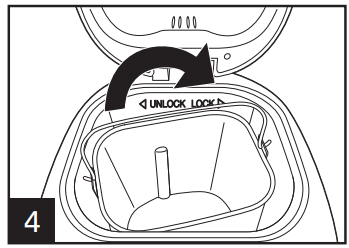
- Plug in the appliance. A beep will be heard and the display will default to Cycle ®.
- Press the CYCLE button until your desired cycle is displayed.
- Preycies 100520, 0, 0, and We the arrow to 1.5- or 2-b. loaf size. (Loaf size is not an option
- Press the CRUST button to move the arrow to desired setting: Light, Medium, or Dark crust. (Crust is not adjustable in Cycles 0, 0, 0, ®, and .)
- If desired, set the DELAY TIMER with the + and - buttons. (Delay function is not available in Cycles 0,, and ©.)
NOTE: Do not use this feature when using dairy, eggs, etc. not mix ingredients until cycle is set to begin. - Varies dyecide to te Timethine Toil yeles char start of the second kneading. Open the lid and pour in your add-ins. This timing
- Once the cycle is complete, the machine will beep 10 times and shift to the Keep Warm setting for 1 hour.
- To stop the machine, press the START/STOP button for 2 seconds and the Keep Warm setting will end.
- Unplug the power cord and then open the lid using oven mitts.
- Let the bread pan cool down slightly before removing the bread. Using oven mitts, carefully turn the bread pan counterclockwise to unlock and lift up on the handle to remove from the machine.
- Using oven mitts, turn the bread pan upside down (with the bread pan handle folded down) onto a wire cooling rack or clean cooking surface and gently shake until bread falls out. Use a nonstick spatula to gently loosen the sides of the bread from the bread pan.
- If kneading podel cordains in the bread, gently pry it out using a spatula or small utensil. When not in use or when operation is complete, unplug the power cord.
NOTE: Store remaining bread in a sealed plastic bag for up to three days at room temperature. To store for a longer time, place sealed plastic bag in refrigerator for up to 10 days.
Timetable for Cycles
CYCLE |
FIRST KNEADING |
FIRST DOUGH RISE |
ADD INGREDIENTS AT BEEP |
SECOND KNEADING |
SECOND DOUGH RISE |
THIRD DOUGH RISE |
BAKE |
TOTAL TIME |
KEEP WARM (1 HOUR) |
| 9 min. | 20 min. | – | 14 min. | 25 min. | 45 min. | 1 hr. | 2 hrs. 53 min. | Yes |
2 lb. | 10 min. | 20 min. | – | 15 min. | 25 min. | 45 min. | 1 hr. 5 min. | 3 hrs. | Yes |
| 16 min. | 40 min. | – | 19 min. | 30 min. | 50 min. | 1 hr. 5 min. | 3 hrs. 40 min. | Yes |
2 lb. | 18 min. | 40 min. | – | 22 min. | 30 min. | 50 min. | 1 hr.10 min. | 3 hrs. 50 min. | Yes |
| 9 min. | 25 min. | – | 18 min. | 35 min. | 1 hr.10 min. | 55 min. | 3 hrs. 32 min. | Yes |
2 lb. | 10 min. | 25 min. | – | 20 min. | 35 min. | 1 hr.10 min. | 1 hr. | 3 hrs. 40 min. | Yes |
| 7 min. | 5 min. | – | 8 min. | 1 hr. 20 min. | 1 hr. 40 min. | Yes | ||
| 10 min. | 5 min. | – | 20 min. | 30 min. | 55 min. | 50 min. | 2 hrs. 50 min. | Yes |
2 lb. | 10 min. | 5 min. | – | 20 min. | 30 min. | 50 min. | 1 hr. | 2 hrs. 55 min. | Yes |
| 12 min. | 11 min. | – | – | – | – | 35 min. | 58 min. | Yes |
| 9 min. | 9 min. | – | – | – | – | 40 min. | 58 min. | Yes |
| 20 min. | 30 min. | – | – | 40 min. | – | – | 1 hr. 30 min. | No |
| – | – | – | – | – | – | 1 hr. 20 min. | 1 hr. 20 min. | No |
| 10 min. | 5 min. | – | 20 min. | 30 min. | 35 min. | 1 hr.10 min. | 2 hrs. 50 min. | Yes |
| 15 min. | 40 min. | – | 5 min. | 25 min. | 40 min. | 50 min. | 2 hrs. 55 min. | Yes |
2 lb. | 15 min. | 40 min. | – | 5 min. | 25 min. | 40 min. | 55 min. | 3 hrs. | Yes |
| – | – | – | – | – | – | 1 hr. | 1 hr. | Yes |
Each of the cycles of the bread maker have different amounts of time devoted to kneading, rising, and/or baking. The chart below shows how many minutes are in each phase for specific cycles.
NOTE: Total Time adds all of those phases together. It does not include any delayed start time.
Removing Bread
Bread pan and baking chamber will be hot and oven mitts should be used. Remove the bread pan by lifting the handle and turning it counterclockwise to unlock it from the base of the chamber. Carefully shake the bread upside down until the loaf falls out of the bread pan. Allow to cool on a wire rack for 10 minutes before slicing.
TIP: If the kneading paddle comes out in the loaf, remove it with a spatula or small utensil.
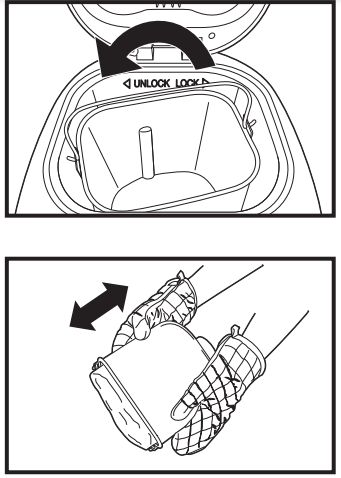
- When baking is complete, the unit will switch to the Keep Warm setting for up to 1 hour.
- Press and hold the START/STOP button for 2 seconds to end this cycle before removing bread pan.
Slicing
Allow to cool for 10 minutes and slice with a bread knife.
Storing Homemade Bread
Fresh-baked bread is best when consumed as soon as possible. To store, wrap cooled loaf in foil or a plastic bag to preserve freshness. Bread can be frozen for up to 6 months.
Cleaning Hamilton Beach HomeBaker Breadmaker 29881
WARNING: Electrical Shock Hazard. Disconnect power before cleaning. Do not immerse cord, plug, or housing in any liquid. Allow breadmaker to cool down completely before cleaning.
- To clean kneading paddle:
If the kneading paddle is difficult to remove from the bread, add water to the bottom of the bread pan and allow to soak for up to 1 hour. Wipe the paddle carefully with a damp cloth. The kneading paddle is dishwasher-safe. - To clean bread pan:
Remove the bread pan by turning it counterclockwise. Wipe inside and outside of bread pan with a damp cloth. Do not use any abrasive agents, in order to protect the nonstick coating. The bread pan must be dried completely before installation.
NOTE: The bread pan and kneading paddles are dishwasher-safe. The outside of the bread pan and base may discolor. This is normal. - To clean housing and top lid: After use, allow unit to cool. Use a damp cloth to wipe lid, housing, baking chamber, and interior of viewing window. Do not use any abrasive cleaners for cleaning, since this will degrade the high polish of the surface. Never immerse the housing into water for cleaning.
- Before the breadmaker is packed for storage, ensure that it has completely cooled down, is clean and dry, and the top lid is closed.
Tips Bread Basics
Ingredients
Two things can ensure a perfect loaf of bread: using fresh, quality ingredients and measuring them accurately.
Flour
- All-Purpose Flour: Flour that contains no baking powder, suitable for “quick” breads or bread made with the Quick settings. Bread flour is better suited for yeast breads.
- Bread Flour: Bread flour is the most important ingredient of making bread and is recommended in most yeast-bread recipes. It has a high gluten content and can keep the size of the bread from collapsing after rising. Flour varies by region. For example, American flour is milled from hard spring wheat; Canadian flour is milled from hard winter wheat.
- Self-Rising Flour: Flour that contains baking powder, used especially for making cakes. Do not use self-rising flour in combination with yeast.
- Whole-Wheat Flour: Whole-wheat flour is ground from the entire wheat kernel. Bread made with all or part whole-wheat flour will have higher fiber and nutritional content. Whole-wheat flour is heavier and, as a result, loaves may be smaller in size and have a heavier texture.
Tip:
To check whether the yeast is fresh and active:
- Pour 1 cup (237 ml) hot tap water into a measuring cup.
- Add 1 teaspoon (5 ml) white sugar and 1 Tablespoon (15 ml) yeast.
- Place the measuring cup in a warm place for about 5 minutes.
- Fresh, active yeast will begin to bubble or “grow.” If it does not, the yeast is dead or inactive.
Other Ingredients
- Egg: Eggs can improve bread texture and make the bread larger in size. The egg must be whisked in with the other liquid ingredients.
- Salt: Salt is necessary to improve the bread flavor and crust color. It is also used to restrain yeast activity.
- Shortening, Butter, and Vegetable Oil: Shortening and butter should be cut into small pieces before adding to liquid.
- Sugar: Sugar is “food” for the yeast and also increases the sweet taste and color of bread. It is a very important element of making the bread rise. White sugar is normally used; however, brown sugar, powdered sugar, or cotton sugar may also be called for in some recipes.
- Water and Other Liquids (always added first): Water is an essential ingredient for making bread. Generally speaking, water should be at room temperature. Some recipes may call for milk or other liquids. Never use dairy with the Delay Timer option.
- Yeast: Yeast is a living organism and should be kept in the refrigerator to remain fresh. It needs carbohydrates found in sugar and flour as nourishment. Yeast used in breadmaker recipes will be sold under several different names: Bread machine yeast (preferred), active-dry yeast, and instant yeast. Before using, check the expiration date of the yeast. Return to refrigerator immediately after each use.
Troubleshooting
PROBLEM | PROBABLE CAUSE | SOLUTION |
Odor or burning smell. | • Flour or other ingredients have spilled into the baking chamber. | • Stop the breadmaker and allow to cool completely. Wipe excess flour, etc., from the baking chamber with a paper towel. TIP: Measure ingredients over the counter, adding them to the bread pan prior to insertion into the machine. |
Ingredients not blending; can hear motor turning. | • Bread pan or kneading paddle may not be installed properly. • Too many ingredients. | • Make sure kneading paddle is set all the way on shaft. • Measure ingredients accurately. |
“HHH” displays when START/STOP button is pressed. | • Internal temperature of breadmaker is too high. | • Allow unit to cool down in between cycles. Unplug unit, open lid, and remove bread pan. Allow to cool 15–30 minutes before beginning new cycle. |
Window is cloudy or covered with condensation. | • May occur during mixing or rising cycles. | • Condensation usually disappears during baking cycle. Clean window well in between uses. |
Kneading paddle comes out with the bread. | • Thicker crust with dark crust setting. | • It is not uncommon for the kneading paddle to come out with the bread loaf. Once the loaf cools, remove the paddle with a spatula. • Choose a lighter crust (Cycles |
Dough is not blending thoroughly; flour and other ingredients are built up on sidesof pan; bread loaf is coatedwith flour. |
|
|
Bread rises too high or pushes lid up. |
|
|
Bread does not rise; loaf is short. |
|
|
Bread has a crater in the top of the loaf once baked. |
|
|
Crust color is too light. |
|
|
Crust color is too dark. |
|
|
Bread loaf is lopsided. |
|
|
Loaves made are different shapes. |
|
|
Bottom of loaf is soggy. |
|
|
Bread is hollow or holey inside. |
|
|
Underbaked or sticky, doughy bread. |
|
|
Bread mashes down when slicing. |
|
|
Bread has a heavy,thick texture. |
|
|
Base of bread pan has darkened or is spotted. |
|
|
Pros & Cons
Pros:
- 12 bread settings, including gluten-free and artisan options
- Delay timer for fresh bread in the morning
- Large viewing window to check on the bread as it bakes
- Easy to clean with dishwasher-safe parts
- Affordable price point
Cons:
- Bread may be too small for some preferences
- No option for custom cycles
- Loud beeping sound at the end of the cycle
- Non-stick coating may wear off over time
Warranty
This warranty applies to products purchased and used in the U.S. and Canada. This is the only express warranty for this product and is in lieu of any other warranty or condition. This product is warranted to be free from defects in material and workmanship for a period of five (5) years from the date of original purchase in Canada and one (1) year from the date of original purchase in the U.S. During this period, your exclusive remedy is repair or replacement of this product or any component found to be defective, at our option; however, you are responsible for all costs associated with returning the product to us and our returning a product or component under this warranty to you. If the product or component is no longer available, we will replace with a similar one of equal or greater value.
Hamilton Beach HomeBaker Breadmaker 29881 Customer Reviews
Customers have praised the Hamilton Beach HomeBaker Breadmaker 29881 for its ease of use and versatility. Many have noted that the bread made in this machine is delicious and of high quality. However, some have noted that the bread is smaller than expected and that the non-stick coating may wear off over time. The most common complaint is the loud beeping sound at the end of the cycle, which some customers have found to be disruptive.
Faqs
What is the capacity of the HomeBaker Breadmaker 29881?
Can I use my favorite HomeBaker Breadmaker 29881 bread recipes?
What will happen if I leave HomeBaker Breadmaker 29881 the bread in the bread pan after baking?
How do I clean the HomeBaker Breadmaker 29881?
Can I make jam or chutney in this HomeBaker Breadmaker 29881?
How can bread mixes be used in the HomeBaker Breadmaker 29881what setting?
How long does it take HomeBaker Breadmaker 29881 to make a loaf of bread?
Can I add mix-ins like nuts or raisins to my HomeBaker Breadmaker 29881?
What is the warranty on this HomeBaker Breadmaker 29881?
What is the difference between American flour and Canadian Flour in HomeBaker Breadmaker 29881?
Leave a Comment
